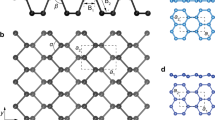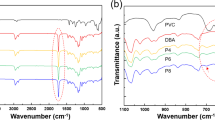Abstract
Vanadium oxides, such as V2O5, are promising for lithium-ion batteries1,2, catalysis3, electrochromic devices4,5 and sensors6,7. Vanadium oxides were proposed more than a decade ago for another redox-dependent application: the direct conversion of electrical energy to mechanical energy in actuators (artificial muscles)8. Although related conducting polymer8,9 and carbon nanotube actuators10 have been demonstrated, electromechanical actuators based on vanadium oxides have not be realized. V2O5 nanofibres6,11 and nanotubes12 provide the potential advantages of low-cost synthesis by sol–gel routes and high charging capacity and long cycle life13,14. Here, we demonstrate electromechanical actuation for obtained high modulus V2O5 sheets comprising entangled V2O5 nanofibres. The high surface area of these V2O5 sheets facilitates electrochemical charge injection and intercalation that causes the electromechanical actuation. We show that the V2O5 sheets provide high Young's modulus, high actuator-generated stress, and high actuator stroke at low applied voltage.
This is a preview of subscription content, access via your institution
Access options
Subscribe to this journal
Receive 12 print issues and online access
$259.00 per year
only $21.58 per issue
Buy this article
- Purchase on Springer Link
- Instant access to full article PDF
Prices may be subject to local taxes which are calculated during checkout




Similar content being viewed by others
References
Poizot, P., Grugeon, S., Dupont, L. & Tarascon J.-M. Nano-sized transition-metal oxides as negative-electrode materials for lithium-ion batteries. Nature 407, 496–499 (2000).
Julien, C., Haro-Poniatowski, E., Camacho-López, M.A., Escobar-Alarcón, L. & Jiménez-Jarquín, J. Growth of V2O5 thin films by pulsed laser deposition and their applications in lithium microbatteries. Mater. Sci. Eng. B 65, 170–176 (1999).
Ponzi, M., Duschatzky, C., Carrascull, A. & Ponzi, E. Obtaining benzaldehyde via promoted V2O5 catalysts. Appl. Catal. A 169, 373–379 (1998).
Granqvist, C.G. Handbook of Inorganic Electrochromic Materials (Elsevier Science, Amsterdam, 1995).
Talledo, A. & Granqvist, C.G. Electrochromic vanadium pentoxide based film - structural, electrochemical, and optical properties. J. Appl. Phys. 77, 4655–4666 (1995).
Livage, J. Vanadium Pentoxide Gels. Chem. Mater. 3, 578–593 (1991).
Micocci, G. et al. Properties of vanadium oxide thin films for ethanol sensor. J. Vac. Sci. Technol. A 15, 34–38 (1997).
Baughman, R.H. et al. in Conjugated Polymeric Materials: Opportunities in Electronics, Optoelectronics, and Molecular Electronics Vol. 182 of NATO ASI Series E: Applied Sciences (eds Bredas, J.L. & Chance, R.R.) 559–582 (Kluwer, Dordrecht, Netherlands, 1990).
Jager, E.W.H., Smela, E. & Inganäs, O. Microfabricating conjugated polymer actuators. Science 290, 1540–1545 (2000).
Baughman, R.H. et al. Carbon nanotube actuators. Science 284, 1340–1344 (1999).
Bailey, J.K., Pozarnsky, G.A. & Mecartney, M.L. The direct observation of structural development during vanadium pentoxide gelation. J. Mater. Res. 7, 2530–2537 (1992).
Muhr, H.-J. et al. Vanadium oxide nanotubes - A new flexible vanadate nanophase. Adv. Mater. 12, 231–233 (2000).
Cazzanelli, E., Mariotto, G., Passerini, F. & Decker, F. Spectroscopic investigations of Li-intercalated V2O5 polycrystalline films. Solid State Ionics 70/71, 412–416 (1994).
Coustier, F., Passerini, S. & Smyrl, W.H. A 400 mAh/g aerogel-like V2O5 cathode for rechargeable lithium batteries. J. Electrochem. Soc. 145, L73–L74 (1998).
Livage, J. Synthesis of polyoxovanadates via “chimie douce”. Coord. Chem. Rev. 178–180, 999–1018 (1998).
Yao, T., Oka, Y., & Yamamoto, N. Layered structures of vanadium pentoxide gels. Mater. Res. Bull. 27, 669–675 (1992).
Huber, J.E., Fleck, N.A., & Ashby, M.F. The selection of mechanical actuators based on performance indices. Proc. R. Soc. Lond. A 453, 2185–2205 (1997).
Muster, J. et al. Electrical transport through individual vanadium pentoxide nanowires. Adv. Mater. 12, 420–423 (2000).
Enjalbert, R. & Galy, J. A refinement of the structure of V2O5 . Acta Crystallogr. A 42, 1467–1469 (1986).
Meulenkamp, E.A., van Klinken, W. & Schlatmann, A.R. In-situ X-ray diffraction of Li intercalation in sol-gel V2O5 films. Solid State Ionics 126, 235–244 (1999).
S̆urca, A., Orel, B., Draz̆ic, G. & Pihlar, B. Ex situ and in situ infrared spectroelectrochemical investigations of V2O5 crystalline films. J. Electrochem. Soc. 146, 232–242 (1999).
Petkov, V. et al. Structure of V2O5·nH2O xerogel solved by the atomic pair distribution function technique. J. Am. Chem. Soc. 124, 10157–10162 (2002).
Pan, Z.W., Dai, Z.R. & Wang, Z.L. Nanobelts of semiconducting oxides. Science 291, 1947–1949 (2001).
Gabriel, J.-C.P. & Davidson, P. New trends in colloidal liquid crystals based on mineral moieties. Adv. Mater. 12, 9–20 (2000).
Acknowledgements
The authors are grateful to M. Schmid, U. Waizmann, M. Riek and T. Reindl for technical assistance and to M. Burghard and X. C. Shen for helpful discussions. This work was partially supported by the Defense Advanced Projects Agency grants N00173-99-2000 and MDA 972-02-C-0005. G.G. and G.T.K. thank the Alexander von Humboldt Foundation for support. Additional support from the Robert A. Welch Foundation is also gratefully acknowledged.
Author information
Authors and Affiliations
Corresponding authors
Ethics declarations
Competing interests
The authors declare no competing financial interests.
Rights and permissions
About this article
Cite this article
Gu, G., Schmid, M., Chiu, PW. et al. V2O5 nanofibre sheet actuators. Nature Mater 2, 316–319 (2003). https://doi.org/10.1038/nmat880
Received:
Accepted:
Published:
Issue Date:
DOI: https://doi.org/10.1038/nmat880
This article is cited by
-
Functionally antagonistic polyelectrolyte for electro-ionic soft actuator
Nature Communications (2024)
-
Tuning electronic and magnetic properties through disorder in V2O5 nanoparticles
Scientific Reports (2023)
-
Actuators with nanofiber mat electrodes: effect of electrode preparation method on actuator performance
Polymer Journal (2021)
-
Unipolar-stroke Electrochemical Artificial Muscles
Advanced Fiber Materials (2021)
-
Lattice-contraction triggered synchronous electrochromic actuator
Nature Communications (2018)



